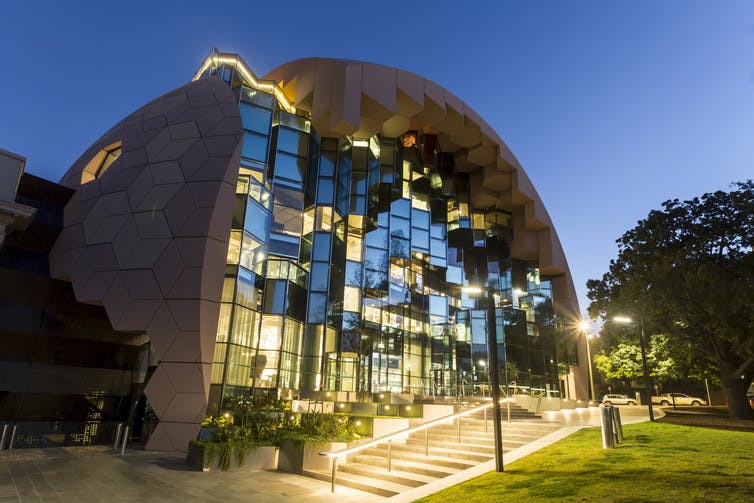By Danielle Wyatt and Dale Leorke/The Conversation
In 2017, archaeologists discovered the ruins of the oldest public library in Cologne, Germany. The building may have housed up to 20,000 scrolls, and dates back to the Roman era in the second century. When literacy was restricted to a tiny elite, this library was open to the public. Located in the center of the city in the marketplace, it sat at the heart of public life.
We may romanticize the library filled with ancient books as an institution dedicated to the interior life of the mind. But the Cologne discovery tells us something else; it suggests libraries may have meant something more to cities and their inhabitants than being just repositories of the printed word.
 We romanticize libraries as being repositories of ancient knowledge/Clarisse Meyer, Unsplash
We romanticize libraries as being repositories of ancient knowledge/Clarisse Meyer, Unsplash
Contemporary public libraries tell us this. Membership has generally declined or flat-lined, but people are now using libraries for more than borrowing books. Children come to play video games or complete homework assignments together. People go to hear lectures and musical performances, or attend craft workshops and book clubs.
Libraries have become vital for the marginalized, such as the homeless, to access essential government services, and to stay connected. They have become de facto providers of basic digital literacy training – such as how to use an iPad or access an eGov account. Others cater to tech enthusiasts offering advanced courses on coding or robotics in purpose-built spaces and laboratories.
 The State Library in Victoria, Australia illustrates that libraries are so much more than just places that contain books/Shutterstock
The State Library in Victoria, Australia illustrates that libraries are so much more than just places that contain books/Shutterstock
How Libraries Are Changing
In the early 2000s, as archives shifted online, futurists predicted an imminent death to public libraries. But the threat of obsolescence made libraries take proactive steps to remain relevant in a digital world. They thought creatively about how to translate services they have always offered – universal access to information – into new formats.
Libraries digitized their collections and networked their catalogues, exponentially extending the range of materials users could access. They introduced e-books and e-readers to read them with. They mounted screens that could be used to watch movies or to play video games on.
They also installed computers crucial to the population who doesn’t have access to the Internet at home. And they wired up their spaces with free WiFi, retrofitting extra power-points so users could plug in their own devices.
 Libraries have a lot of programs around technology and the use of computers/Shutterstock
Libraries have a lot of programs around technology and the use of computers/Shutterstock
Besides offering new technologies and services, libraries offer people a welcoming, safe space to gather without the pressure to spend money. Investing in attractive, versatile furnishings, they have actively encouraged people to dwell in their spaces, whether this is to read a newspaper, complete a job application online, or to study.
In an age where communication technologies create both efficiency as well as forms of isolation, such spaces assume a renewed social importance.
How Libraries Shape The City
As vital as libraries are to individuals, their value is also connected to broader civic agendas. Libraries have deliberately sought to change perceptions of themselves from spaces of collection to spaces of creation. Some see themselves facilitating creativity not only in an artistic sense, but also as entrepreneurial hubs for start-ups and budding innovators.
 This library cost millions of dollars to build, while three local libraries lost funding/Shutterstock
This library cost millions of dollars to build, while three local libraries lost funding/Shutterstock
Public libraries have promoted their relevance to cities by strategically aligning themselves with government visions of economic growth. Others attract high levels of funding as part of urban renewal projects aimed at revitalizing declining urban precincts.
These high-profile libraries, usually in urban centers, overshadow the uncertain fate of smaller libraries on the periphery, fighting to stay viable due to insufficient funding.
This contradiction is occurring because provisioning for libraries is not embedded at high levels of urban planning and policy-making.
Critically and most revealingly, libraries are evaluated based on traditional metrics, such as loan and membership numbers, capturing only a fraction of the full value they contribute to our individual and collective life. Failure to recognize this by governments and policymakers puts at risk the diverse and nuanced ways libraries might shape our future.
Danielle Wyatt is a research fellow at the University of Melbourne. Dale Leorke is a postdoctoral researcher at the University of Tampere. This article was originally published on The Conversation.
–
Previously in libraries:
* Has The Library Outlived Its Usefulness In The Internet Age?
* Honk If You Love Libraries More Than Rahm Does.
–
Comments welcome.
Posted on August 27, 2018


